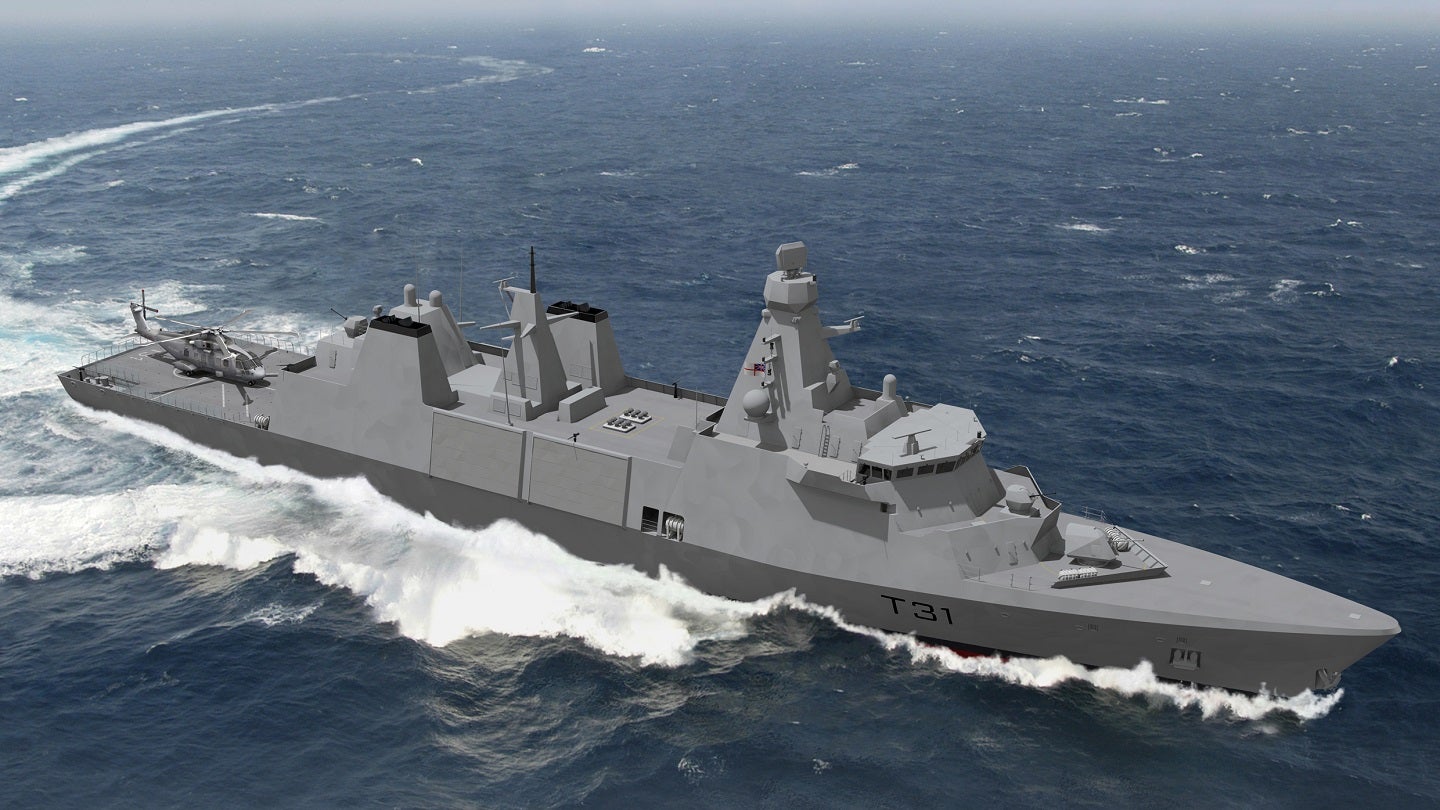
Versatile Capabilities of the Type 31 Frigate Weapons
As UK naval bombshells go, the announcement that the UK’s minimalist Type 31 frigates will be fitted with the Mk41 vertical launch system (VLS), bringing with it a potential new range of anti-surface and anti-air lethality, could take some beating.
During a keynote speech at the Sea Power Conference in London on 17 May, the UK First Sea Lord Admiral Ben Key, stated the Type 31 frigates would receive the Mk41, sending naval watchers into overdrive while simultaneously raising questions over affordability, timelines, and reasoning for a class already well into the construction phase.
Originally designed as a light patrol frigate, the Type 31 was envisaged to feature minimal surface-to-surface attack options, primarily based around the single Mk110 57mm main gun from BAE Systems and two Mk4 40mm secondary weapon systems from Saab Bofors. Anti-air capability was to be provided by the SeaCeptor ‘mushroom farm’, amidships.
The deliberately light kinetic surface attack options, and reuse of existing equipment ported over from the outgoing Type 23 frigates, was determined as the best way to keep the costs down and ensure each of the five frigates was able to be delivered at a cost of £250m per hull.
However, in November 2022 it was announced that the UK would acquire 11 ship sets of the Naval Strike Missile (NSM) from Kongsberg, offering a canister-launched anti-ship missile that would be equipped to the in-service Type 23 and Type 45 vessels. The NSM will effectively replace the outgoing and obsolete Harpoon Block 1C.
Should the canister launched NSM be then removed from Type 23 frigates as they leave service and installed onto the Type 31, the vessel would be able to conduct the full range of anti-ship and anti-air operations, through the NSM and SepCeptor system respectively.
Type 31 undergoing new assessment phase
The announcement of the Mk41 integration raises a number of questions about the programme, which, although the design allows for the installation of the VLS, has been previously finalised to include just the SeaCeptor air-defence capability.
Were the Type 31 to get the NSM sets, what purpose would there be for the installation of the Mk41 VLS? Turning the question around, should the Type 31 frigates not receive the NSM, would the missiles instead be fitted to some or all of the eight Type 26 anti-submarine warfare frigates under construction, which will also feature the Mk41 VSL?
A final, for now, question emerges regarding the prospect that the SeaCeptor air defence system is integrated into the Mk41, instead of the traditional mushroom farm arrangement as seen on the Type 23 frigates and Type 45 air defence destroyers.
These factors could in turn influence the cost of build, at a time when manufacturer Babcock is in dispute with the UK Ministry of Defence over the profitability of the Type 31 programme.
The answers to these questions will likely emerge from a new assessment phase being undertaken by UK stakeholders in the Type 31 programme and the US Navy to determine how the Mk41 could be integrated into the frigate and the potential financial implications.
Speaking to Naval Technology, a Royal Navy spokesperson said: “The Mk41 vertical launching system will deliver surface launched strike operations against a full spectrum of targets. Working closely with the US Navy, we have commenced an assessment phase to explore the options and costs associated with fitting T31 with Mk41. It is too early to provide any further information whilst this commercially sensitive work is ongoing.”
Any delays in the Type 31 build, which already looks tight given the turnaround of effectively one vessel per year, will impact a Royal Navy surface combatant force that looks set to dip to 15 hulls by the middle of the decade as the old Type 23s retire.
According to the UK’s shipbuilding programme, five Type 31 Inspiration-class general-purpose frigates will be introduced into Royal Navy service from 2027, with Babcock completing the handover of the fifth and final vessel the following year.
What could the Mk41 VLS bring?
In looking to fit the Mk41, the UK could offer a degree of standardisation across its surface combatant fleet with the eight Type 26 anti-submarine warfare frigates also to be fitted with the system.
The Type 45 air defence destroyers could then become an outlier in RN service, as they already feature the 48-cell Sylver VLS for the Aster 15 and Aster 30 missiles, which will be augmented by a further 24-cell SeaCeptor farm. However, the replacement Type 83 class, due to enter service in the late 2030s, could change to the Mk41 or its future derivations.
In doing so, the UK will fall into commonality with the US and many Nato allies already using the Mk41 system, potentially offering the use of a variety of current and future anti-air, anti-surface, ballistic missile defence and strike missiles, including the RN’s Future Offensive Surface Weapon.
James Marques, aerospace and defence analyst at GlobalData, said that the UK admiralty had “long complained” that the RN’s surface fleet was “capable in defence”, but lacked offensives options. The lessons being learned from the ongoing war in Ukraine, and how quickly stocks of expensive high-end missiles can be used up in war, was another factor.
“Harpoon is ageing and was hastily fitted to some Type 45s last year only after Ukraine. I think the appetite to satisfy the Royal Navy’s shopping list has grown massively in 2022, and they are aiming for a force that can credibly move firepower to both the Indo-Pacific and Europe/Nato,” Marques said.
The story of a class of warships, cheap to design, build, and enter into service, thus avoiding the expensive complexity of a larger Type 26 acquisition, still has some chapters left to write.








